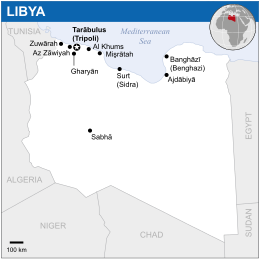Great Socialist People's Libyan Arab Jamahiriya (1977–2011)
| Socialist People's Libyan Arab Jamahiriya (1977–1986) الجماهيرية العربية الليبية الشعبية الاشتراكية al-Jamāhīrīyah al-'Arabīyah al-Lībīyah ash-Sha'bīyah al-Ishtirākīyah Great Socialist People's Libyan Arab Jamahiriya (1986–2011) الجماهيرية العربية الليبية الشعبية الإشتراكية العظمى al-Jamāhīrīyah al-'Arabīyah al-Lībīyah ash-Sha'bīyah al-Ishtirākīyah al-'Uẓmá | |
|---|---|
| 1977–2011 | |
 | |
| Government | Islamic socialist jamahiriya |
• Leader of the Revolution | Muammar Gaddafi |
• Secretary General of the General People's Congress
(head of state) | Mohamed Abu al-Qasim al-Zwai |
• Secretary General of the General People's Committee
(head of government) | Baghdadi Mahmudi |
| Legislature | General People's Congress |
| History | |
• Established | 1977 |
• Dissolution | 2011 |
| Area | |
• Total | 1,759,541 km² |
| Population | |
• 2010 estimate | 6,355,100 |
The Great Socialist People's Libyan Arab Jamahiriya was a non-Marxist socialist state in North Africa from 1977 to 2011 led by Muammar Qaddafi. In 2010, Libya had the highest human development index of any country in Africa.[1]
Government
People's Congress
The first formal principle body of the Jamahiriya political framework, the People's Congresses, are mass organizations on a local scale comprising of all registered adults in a local community. It is the smallest, most basic unit of administration in Libyan society. Congresses are organized on the basis of population density, need for services and availability of resources necessary as a means of ensuring the efficiency of the Jamahiriya system. Due to this, the number and size of People's Congressional boundaries may increase or decrease. The People's Congresses had legislative authority and directly considered all domestic and foreign policy issues. Every People's Congress selected a Secretariat to lead the congress and Local People's Committee to supervise and run public services. Two annual meetings of the congresses were to be scheduled by necessity, the first set up to discuss local businesses and set an agenda for the next meeting while the second meeting fills Local People's Committee seats and discusses national and international policy.[2]
People's Congresses located in the same municipality would form a Municipal People's Congress, which is the gathering of People's Congresses, Committees and Trade unions in the area. Each Municipal people's Congress elects a secretariat to lead the congress and a Municipal People's Committee to manage public services within city boundaries.[2]
People's Committee
The second formal principle body of the Jamahiriya political framework, the People's Committees, are the executive arms of the people's committees tasked with the implementation of congressional decisions. The People's Committees are elected directly by the congresses and are headed by a Secretary General. People's Committees have the power to use all economic, social and financial resources to reach policy aims.[2]
At the national level, the General People's Committee is the executive branch of government and equivalent to a Cabinet of Ministers. They are responsible for the operation, performance and activity of ministry level departments. Though their primary focus is implementation, the General People's Committee has the power to propose new legislation/policies as well as amendments to General People's Congress decisions.[2]
Trade Unions and Syndicates
The third formal principle body of the Jamahiriya political framework, the Trade Unions and Syndicates are established by the organization of all Libyan workers into professional associations. Each union would elect their own secretariat to manage affairs and serve as a self-regulatory committee of sorts. Trade Unions and Syndicates were organized in all labor sectors in the Jamahiriya and would appoint a Secretary General to represent them and defend their rights as workers. In practice, Unions and Syndicates were established in the municipal level, with each union sending delegates to participate in the general labor federations of the national level. Professional associations in the Jamahiriya delivered its own secretariat to congressional meetings to represent their interests and speak on issues relevant to their field of work. Their views and demands would take final form in the General People's Congress where they present policy issues during the annual gathering of the congress.[2]
General People's Congress
The fourth formal principle body of the Jamahiriya political framework, the General People's Congress, is a gathering of the secretaries of the Basic People's Congresses, Municipal People's Congresses, People's Committees as well as the Trade Unions and Syndicates. The General People's Congress meets annually, in which it selects and questions members to be appointed to the General Secretariats of the Congress and Committee, as well as higher court judges. The General People's Congress Secretariat is responsible for managing the Congresses activities, such as signing legislation, establishing an agenda of the Basic People's Congresses and organizing sessions. The General People's Committee Secretariat comprises of General Committees tasked with managing daily life and executing the Congress' decisions; its Secretaries are the foreign equivalent to Cabinet Ministers. After all motions have been heard, discussed and voted on, the conclusion of the summit is followed by the transferring of these plans to the General People's Committee to begin the implementation process. Therefore, as the highest legislative and political authority in the Jamahiriya, policies cannot be valid before approval by the General People's Congress[2]
Education
In 2009, the adult literacy rate was 88.4% and the youth literacy rate was 99.8%. 52% of men and 57% of women went to colleges or universities.[3] The government funded students to study abroad for free.[4]
Health
The Libyan Arab Jamahiriya had free universal healthcare for all citizens. Child mortality rate decreased from 71 per 1,000 live births in 1991 to 14 in 2009.[5] Undernourishment was less than 5% and the average citizen ate over 3,000 calories per day. Life expectancy was 74.5 years,[6] the highest in the developing world.[1] Women received $5,000 after the birth of every child.[4]
Housing
Access to a home was considered a human right and electricity was completely free.[4]
Imperialist attacks
In 1986, the United States under Ronald Reagan bombed Libya.[7]
In January 2011, Arab Spring protests spread from Tunisia to Libya. The protests were mostly in the Benghazi region and were supported by the United States and European Union. Between March and October, NATO ran a bombing campaign in Libya. On 20 October 2011, rebels captured and brutally murdered Qaddafi.[6]
References
- ↑ 1.0 1.1 Alexandra Valiente (2011-11-09). "Celebrating The Great Achievments Of Muammar Gaddafi" Libya 360º Archives. Retrieved 2022-04-23.
- ↑ 2.0 2.1 2.2 2.3 2.4 2.5 Abuagela M. Ahmed (2012-12-05) "Examination of the public policy process in Libya" University of Salford. Retrieved 2023-3-17
- ↑ UIS Statistics in Brief. UNESCO. Archived from the original on 2010-09-11.
- ↑ 4.0 4.1 4.2 Steven Meltzer (2014-05-16). "Ten Things You Didn’t Know About Libya Under Gaddafi’s So-Called Dictatorship" Urban Times. Retrieved 2022-04-24.
- ↑ World Health Organization (2007). Libyan Arab Jamahiriyah. [PDF]
- ↑ 6.0 6.1 "Libya: Before and After Muammar Gaddafi" (2020-01-15). TeleSur. Archived from the original on 2021-03-05. Retrieved 2022-06-25.
- ↑ John Pike. "Operation El Dorado Canyon" GlobalSecurity.org. Retrieved 2022-03-30.

